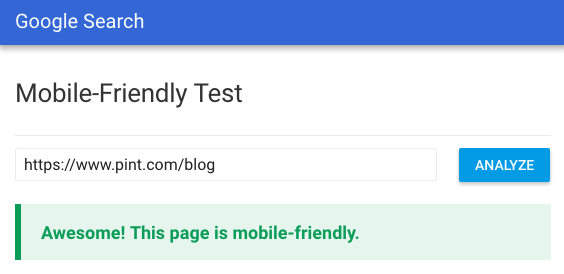
Google AMP in Action
When we talk about Google AMP, we’re not just shouting about an amplifier. We’re talking about Accelerated Mobile Pages. They’re a new feature on the web, and they offer some distinct advantages when implemented on a site.

What is Google AMP?
AMP or Accelerated Mobile Pages are static pages that utilize stricter guidelines than normal HTML pages in order to deliver the fastest pages to mobile devices. On a technical level, Google AMP pages utilize similar tags to HTML pages. Only with AMP, certain tags are not allowed. Others are modified to leverage the AMP JavaScript library. For example:
CSS specs are very similar to the native library, but browser intensive style properties are not allowed.
Javascript is not allowed to make sure pages load quickly and consistently. Developers can utilize AMP specific components from their library to swap from their non-amp pages.
All together, this allows pages to be more standardized across all AMP pages. Plus, it ensures that the focus of the AMP page is to deliver the content as quickly and as efficiently as possible. But it doesn’t diminish key features or hamper marketing efforts.
“AMP files take advantage of various technical and architectural approaches that prioritize speed to provide a faster experience for users. AMP developers can use a rich and growing library of web components that offer the ability to embed rich media objects like video and social posts, display advertising, or collect analytics. The goal is not to homogenize how content looks and feels, but instead to build a more common technical core between pages that speeds up load times.” – AMP FAQs

Benefits of Accelerated Mobile Pages
Mobile Performance
Google AMP pages are, by definition, mobile-friendly. Since they are only accessed by mobile devices, they are served up to users searching on their phones. And they are optimized to load more quickly. The cumulative total of these features is the benefit of better mobile performance.
AMP pages are indexed by google and stored on Google’s own AMP cache. Since AMP pages are so self contained and have relatively small file sizes, Google can actually leverage their own servers to deliver AMP validated content to users, this further streamlining the process.
SEO
Better mobile performance and mobile-friendly pages support SEO (search engine optimization) efforts. This is no rumor: Google has released explicit mobile expectations for developers. This makes sense: some estimate mobile searches to be more than 60% of search traffic.
Google’s algorithm updates for mobile were official in May. At the time, you may have seen “mobile-friendly” labels on your mobile search results when a site was deemed appropriate by Google. Now those labels are disappearing and sites that don’t cut the mustard are being penalized in SERPs.
How big is the penalty? Initial studies suggest it could reduce visibility by as much as 50%. It all depends on the competition for your keywords, how mobile friendly your site is, and how it performs beyond the basic “mobile-friendly” standards.

If you wondering if Google views your site as mobile-friendly, you can use their handy tool.
User Experience

UX (user experience) is also related to Google’s weighting of mobile-friendliness. Our CEO frequently reminds us that the client-side is unpredictable, so we should try and do what we can to ensure server-side programming is as strong as possible. That means we are trying to provide the best experience to people despite client-side drawbacks, such as:
- Small screen sizes
- Browsers that haven’t been updated
- Slower connection speeds
“Sometimes overlooked as an element of UX, page load times are more important than ever. AMP solves the load time problem, but these changes necessitate simplifying pages even further. With relatively few other UI elements available, getting the content right on these mobile pages is really key.” – Carrie Nusbaum, PINT UX Designer
Resources for AMP
- Helpful validator to identify AMP errors –
https://www.ampproject.org/docs/guides/validate.html - Explainer video on AMP and SEO advantages –
https://moz.com/blog/accelerated-mobile-pages-whiteboard-friday
Wondering if AMP Will Work For You?

No, not that amp! Google Accelerated Mobile Pages. Initial reading indicates that AMP would benefit most sites that want to rank better in mobile searches and provide a better user experience to users on mobile devices. If this sounds like you, get in touch. We’ve got team members who can dig in and see what the process would involve for your site.